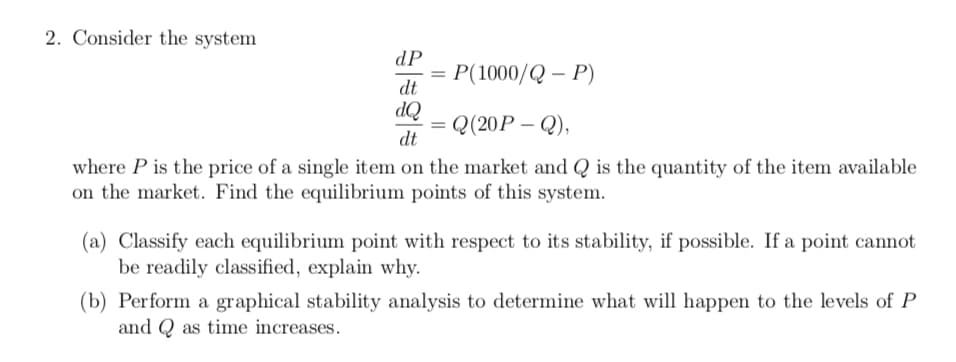2. Consider the system dP P(1000/Q – P) dt OP Q(20P – Q), dt where P is the price of a single item on the market and Q is the quantity of the item available on the market. Find the equilibrium points of this system. (a) Classify each equilibrium point with respect to its stability, if possible. If a point cannot be readily classified, explain why. (b) Perform a graphical stability analysis to determine what will happen to the levels of P and Q as time increases.
2. Consider the system dP P(1000/Q – P) dt OP Q(20P – Q), dt where P is the price of a single item on the market and Q is the quantity of the item available on the market. Find the equilibrium points of this system. (a) Classify each equilibrium point with respect to its stability, if possible. If a point cannot be readily classified, explain why. (b) Perform a graphical stability analysis to determine what will happen to the levels of P and Q as time increases.
Linear Algebra: A Modern Introduction
4th Edition
ISBN:9781285463247
Author:David Poole
Publisher:David Poole
Chapter2: Systems Of Linear Equations
Section2.4: Applications
Problem 23EQ:
23. Consider a simple economy with just two industries: farming and manufacturing. Farming consumes...
Related questions
Question

Transcribed Image Text:2. Consider the system
dP
P(1000/Q – P)
dt
OP
Q(20P – Q),
dt
where P is the price of a single item on the market and Q is the quantity of the item available
on the market. Find the equilibrium points of this system.
(a) Classify each equilibrium point with respect to its stability, if possible. If a point cannot
be readily classified, explain why.
(b) Perform a graphical stability analysis to determine what will happen to the levels of P
and Q as time increases.
Expert Solution
This question has been solved!
Explore an expertly crafted, step-by-step solution for a thorough understanding of key concepts.
Step by step
Solved in 5 steps with 1 images

Knowledge Booster
Learn more about
Need a deep-dive on the concept behind this application? Look no further. Learn more about this topic, advanced-math and related others by exploring similar questions and additional content below.Recommended textbooks for you

Linear Algebra: A Modern Introduction
Algebra
ISBN:
9781285463247
Author:
David Poole
Publisher:
Cengage Learning

Linear Algebra: A Modern Introduction
Algebra
ISBN:
9781285463247
Author:
David Poole
Publisher:
Cengage Learning